Abstract
The teachable moment is the time when a learner is ready to accept new information for use conceptually or in practice. Adult educators are always searching for that "moment" and models in which it has been incorporated. This article reviews the changing paradigm for continuing education of the health professional and the impact of information from the context of university-based providers of continuing education and information. Providers of continuing education and information face similar external opportunities and threats. The continuing education provider is a "marginal dweller" in the organization. The information provider (the library), although moving in that direction as technology affects the way information is accessed and managed, is much more a part of the core institutional mission. These parallel conditions provide opportunities for both organizations to work closely together to identify successful models to serve the "teachable moments" of all health care practitioners. A range of new library roles that suggest strong interaction with continuing educators is presented. Workable models are identified as well as characteristics of successful models. Suggestions for survival for continuing educators and librarians in "stalking the teachable moment" are discussed.
Full text
PDF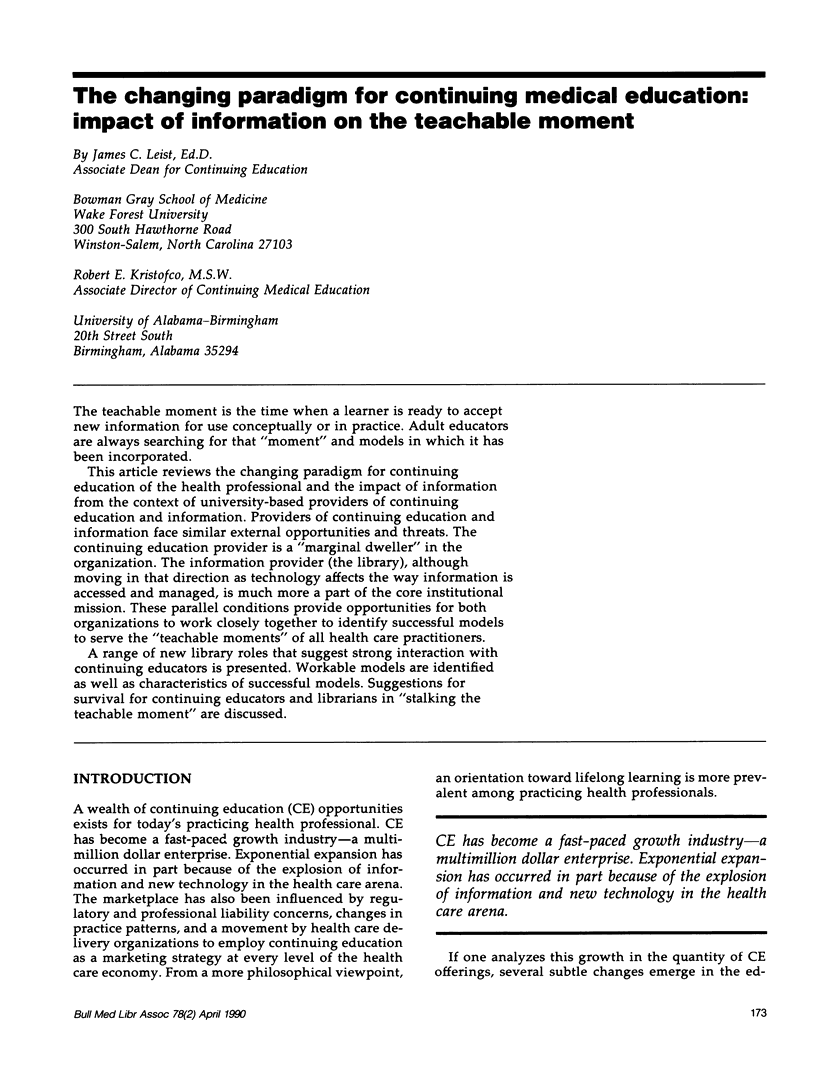
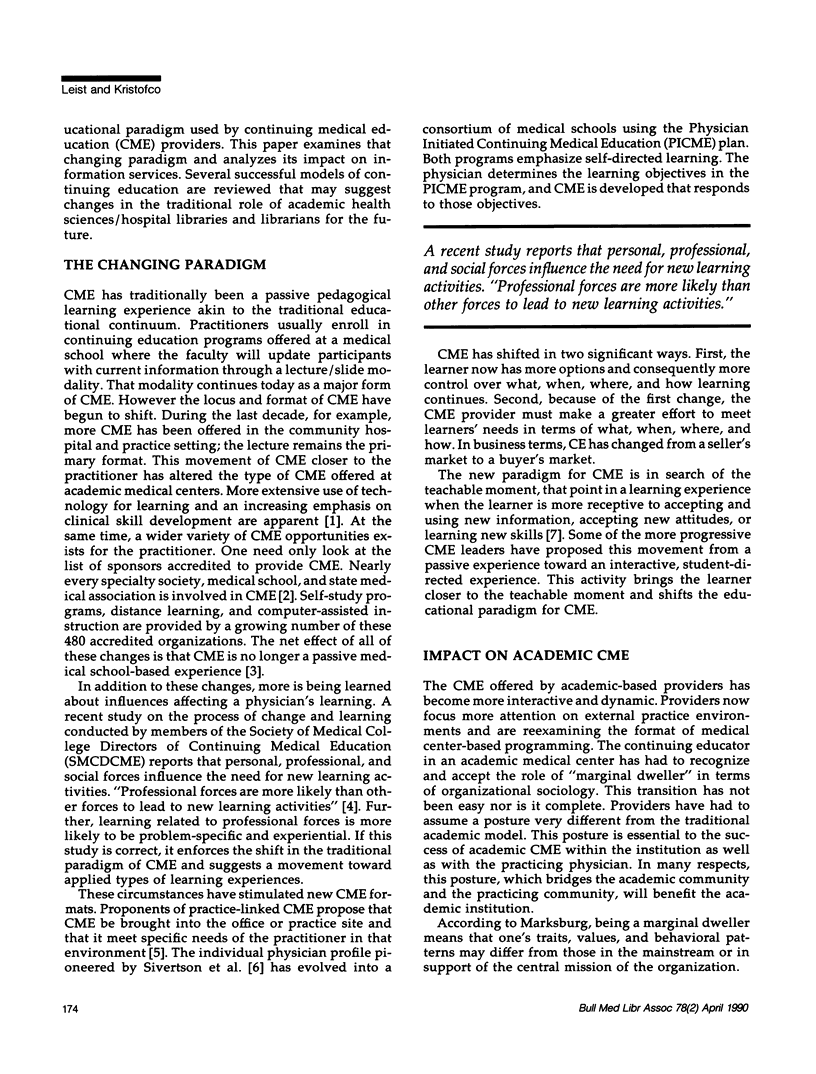

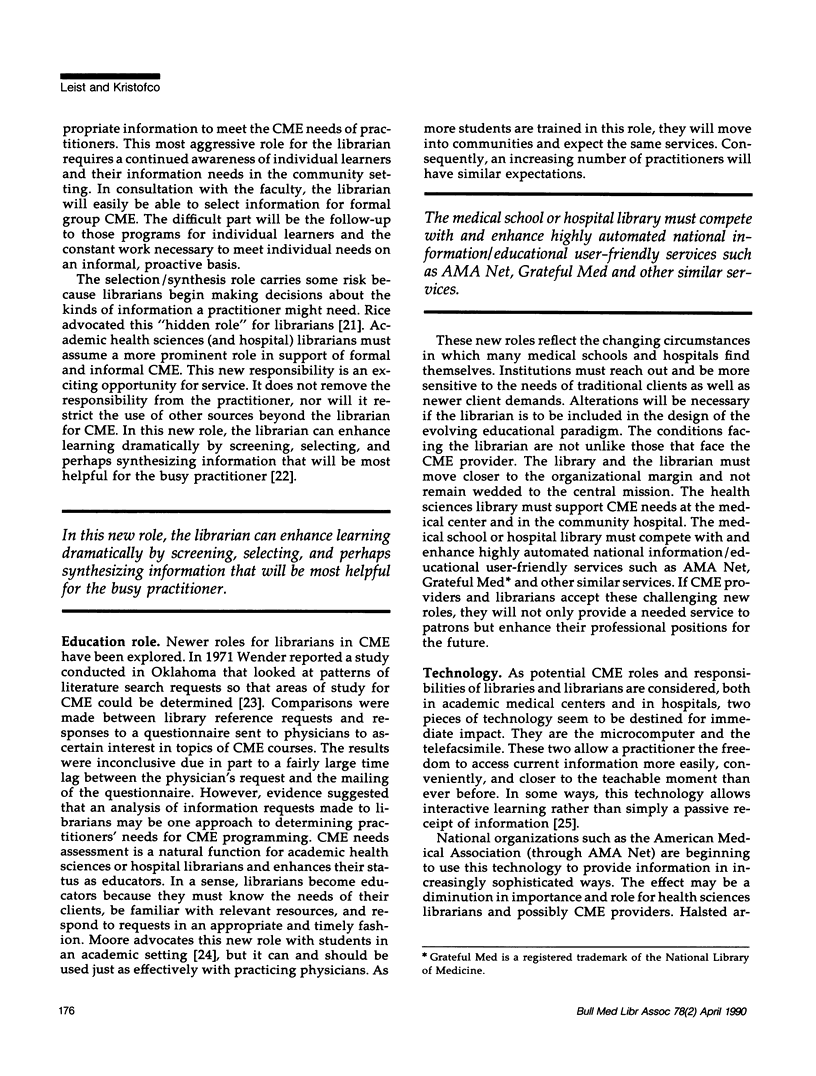
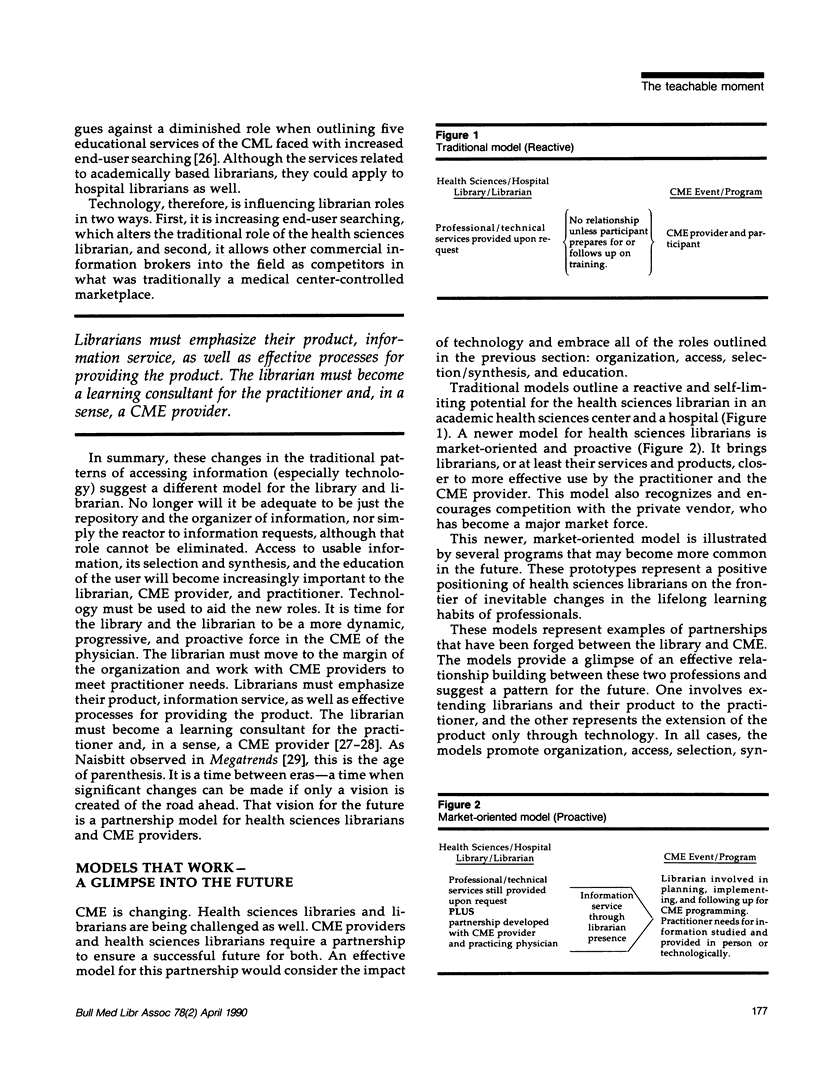
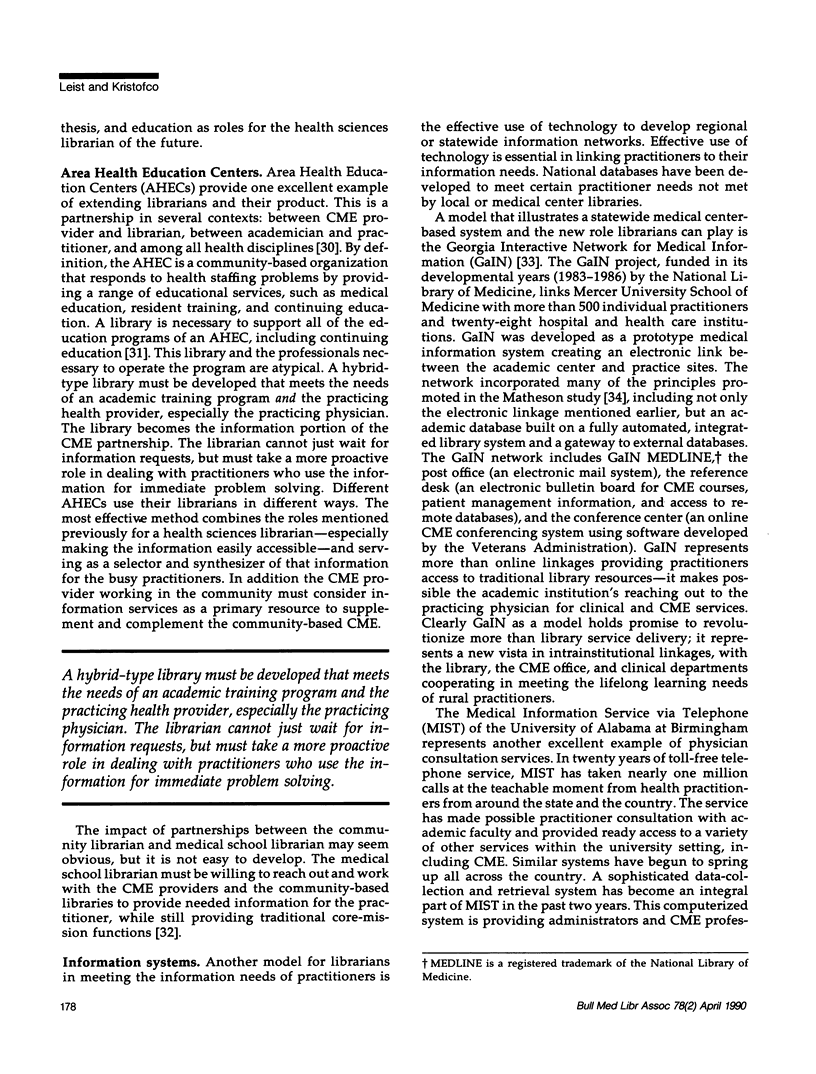
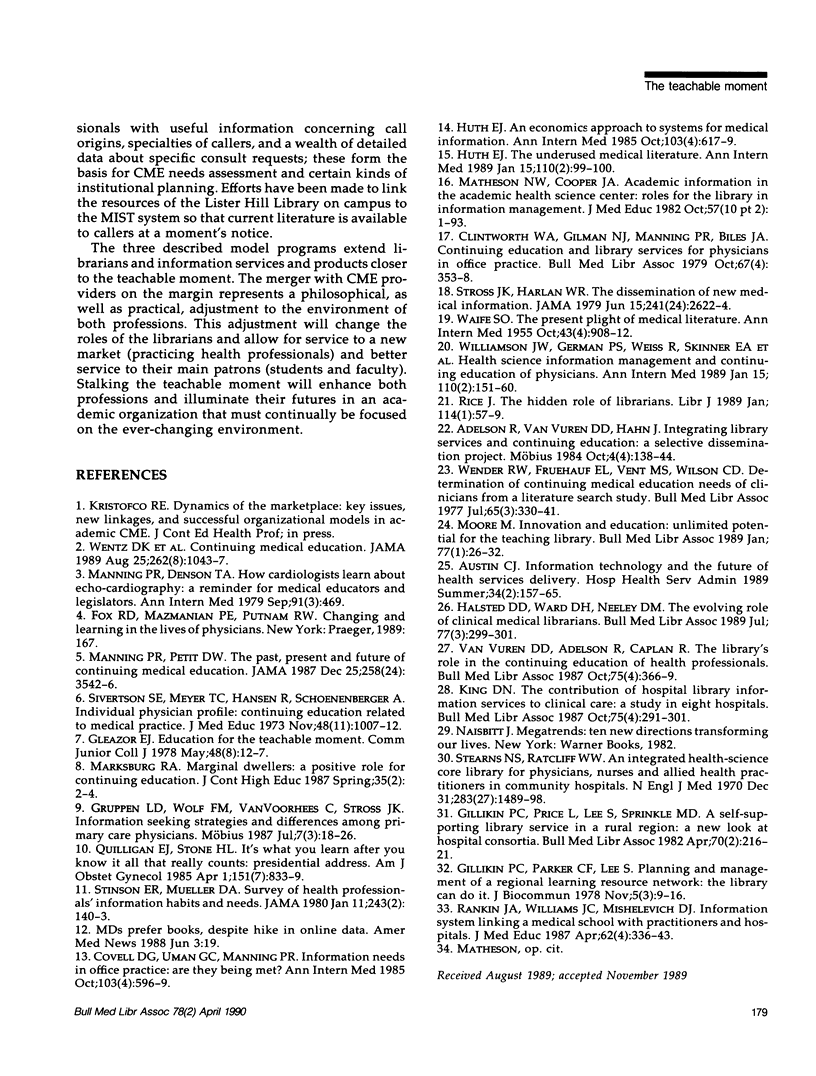
Selected References
These references are in PubMed. This may not be the complete list of references from this article.
- Adelson R., Van Vuren D. D., Hahn J. Integrating library services and continuing education. Mobius. 1984 Oct;4(4):138–144. doi: 10.1002/chp.4760040433. [DOI] [PubMed] [Google Scholar]
- Austin C. J. Information technology and the future of health services delivery. Hosp Health Serv Adm. 1989 Summer;34(2):157–165. [PubMed] [Google Scholar]
- Clintworth W. A., Gilman N. J., Manning P. R., Biles J. A. Continuing education and library services for physicians in office practice. Bull Med Libr Assoc. 1979 Oct;67(4):353–358. [PMC free article] [PubMed] [Google Scholar]
- Covell D. G., Uman G. C., Manning P. R. Information needs in office practice: are they being met? Ann Intern Med. 1985 Oct;103(4):596–599. doi: 10.7326/0003-4819-103-4-596. [DOI] [PubMed] [Google Scholar]
- Gillikin P., Parker C. F., Lee S. Planning and management of a regional learning resource network: the library can do it. J Biocommun. 1978 Nov;5(3):9–16. [PubMed] [Google Scholar]
- Gillikin P., Price L., Lee S., Sprinkle M. D., Leist J. C. A self-supporting library service in a rural region: a new look at hospital consortia. Bull Med Libr Assoc. 1982 Apr;70(2):216–223. [PMC free article] [PubMed] [Google Scholar]
- Gruppen L. D., Wolf F. M., Van Voorhees C., Stross J. K. Information-seeking strategies and differences among primary care physicians. Mobius. 1987;7(3):18–26. doi: 10.1002/chp.4760070306. [DOI] [PubMed] [Google Scholar]
- Halsted D. D., Ward D. H., Neeley D. M. The evolving role of clinical medical librarians. Bull Med Libr Assoc. 1989 Jul;77(3):299–301. [PMC free article] [PubMed] [Google Scholar]
- Huth E. J. Needed: an economics approach to systems for medical information. Ann Intern Med. 1985 Oct;103(4):617–619. doi: 10.7326/0003-4819-103-4-617. [DOI] [PubMed] [Google Scholar]
- Huth E. J. The underused medical literature. Ann Intern Med. 1989 Jan 15;110(2):99–100. doi: 10.7326/0003-4819-110-2-99. [DOI] [PubMed] [Google Scholar]
- King D. N. The contribution of hospital library information services to clinical care: a study in eight hospitals. Bull Med Libr Assoc. 1987 Oct;75(4):291–301. [PMC free article] [PubMed] [Google Scholar]
- Manning P. R., Denson T. A. How cardiologists learn about echocardiography. A reminder for medical educators and legislators. Ann Intern Med. 1979 Sep;91(3):469–471. doi: 10.7326/0003-4819-91-3-469. [DOI] [PubMed] [Google Scholar]
- Manning P. R., Petit D. W. The past, present, and future of continuing medical education. Achievements and opportunities, computers and recertification. JAMA. 1987 Dec 25;258(24):3542–3546. [PubMed] [Google Scholar]
- Matheson N. W., Cooper J. A. Academic information in the academic health sciences center. Roles for the library in information management. J Med Educ. 1982 Oct;57(10 Pt 2):1–93. doi: 10.1097/00001888-198210000-00001. [DOI] [PubMed] [Google Scholar]
- Moore M. Innovation and education: unlimited potential for the teaching library. Bull Med Libr Assoc. 1989 Jan;77(1):26–32. [PMC free article] [PubMed] [Google Scholar]
- Quilligan E. J., Stone H. L. It's what you learn after you know it all that really counts. Presidential address. Am J Obstet Gynecol. 1985 Apr 1;151(7):833–839. doi: 10.1016/0002-9378(85)90659-3. [DOI] [PubMed] [Google Scholar]
- Rankin J. A., Williams J. C., Mishelevich D. J. Information system linking a medical school with practitioners and hospitals. J Med Educ. 1987 Apr;62(4):336–343. doi: 10.1097/00001888-198704000-00005. [DOI] [PubMed] [Google Scholar]
- Stearns N. S., Ratcliff W. W. An integrated health-science core library for physicians, nurses and allied health practitioners in community hospitals. N Engl J Med. 1970 Dec 31;283(27):1489–1498. doi: 10.1056/NEJM197012312832704. [DOI] [PubMed] [Google Scholar]
- Stinson E. R., Mueller D. A. Survey of health professionals' information habits and needs. Conducted through personal interviews. JAMA. 1980 Jan 11;243(2):140–143. [PubMed] [Google Scholar]
- Stross J. K., Harlan W. R. The dissemination of new medical information. JAMA. 1979 Jun 15;241(24):2622–2624. [PubMed] [Google Scholar]
- Van Vuren D. D., Adelson R., Caplan R. The library's role in the continuing education of health professionals. Bull Med Libr Assoc. 1987 Oct;75(4):366–369. [PMC free article] [PubMed] [Google Scholar]
- WAIFE S. O. The present plight of medical literature. Ann Intern Med. 1955 Oct;43(4):908–912. doi: 10.7326/0003-4819-43-4-908. [DOI] [PubMed] [Google Scholar]
- Wender R. W., Fruehauf E. L., Vent M. S., Wilson G. D. Determination of continuing medical education needs of clinicians from a literature search study, Part I. The study. Bull Med Libr Assoc. 1977 Jul;65(3):330–337. [PMC free article] [PubMed] [Google Scholar]
- Wentz D. K., Gannon M. I., Osteen A. M., Baldwin D. C., Jr Continuing medical education. JAMA. 1989 Aug 25;262(8):1043–1047. [PubMed] [Google Scholar]
- Williamson J. W., German P. S., Weiss R., Skinner E. A., Bowes F., 3rd Health science information management and continuing education of physicians. A survey of U.S. primary care practitioners and their opinion leaders. Ann Intern Med. 1989 Jan 15;110(2):151–160. doi: 10.7326/0003-4819-110-2-151. [DOI] [PubMed] [Google Scholar]


